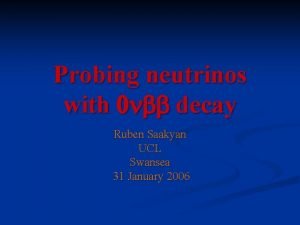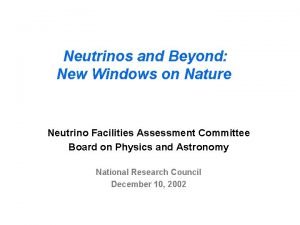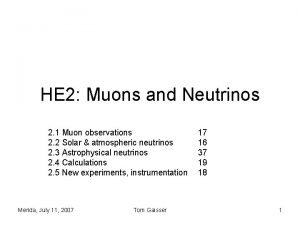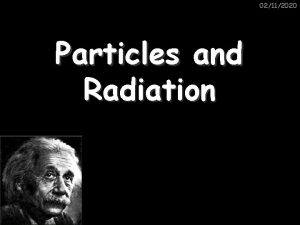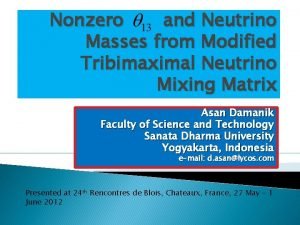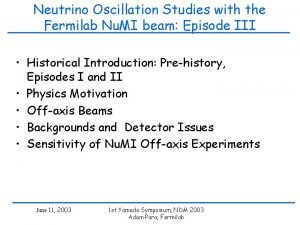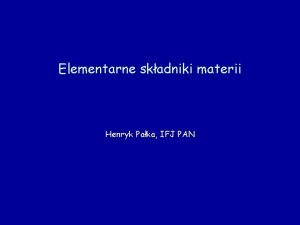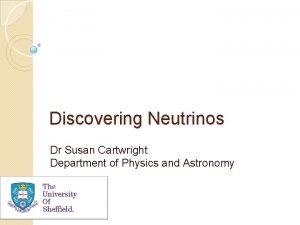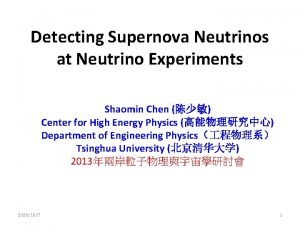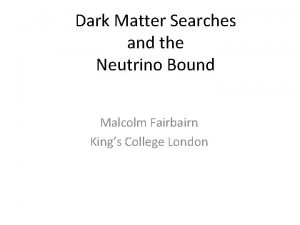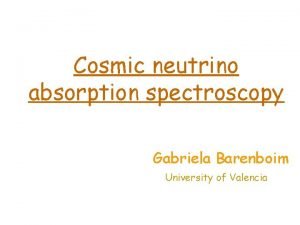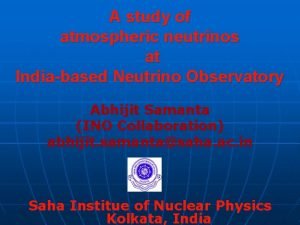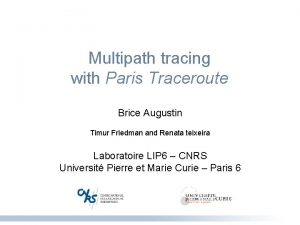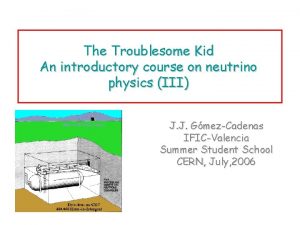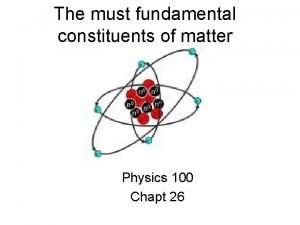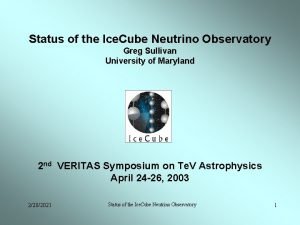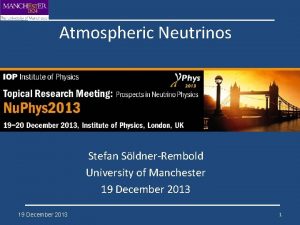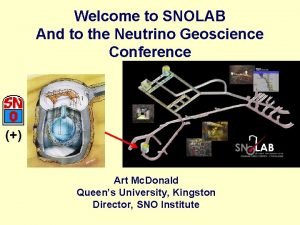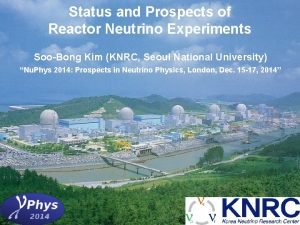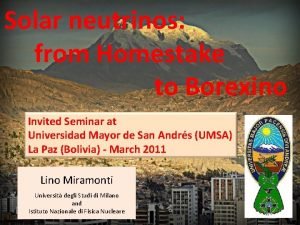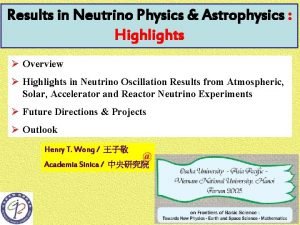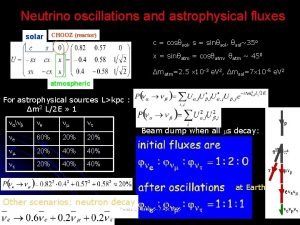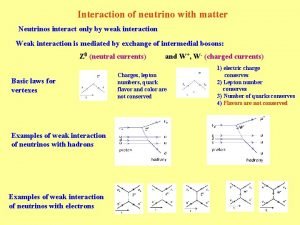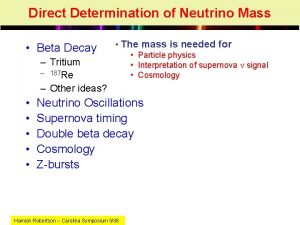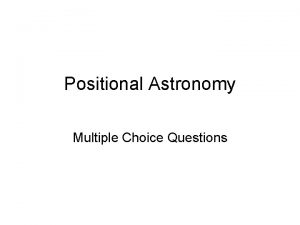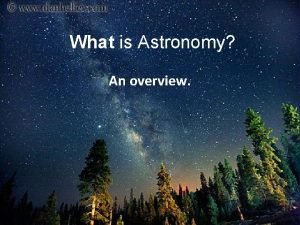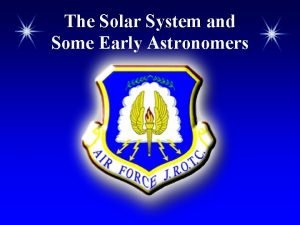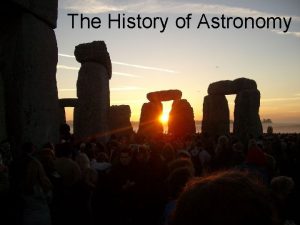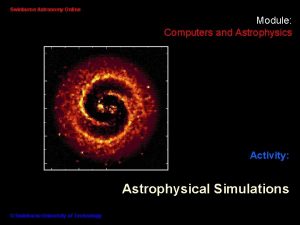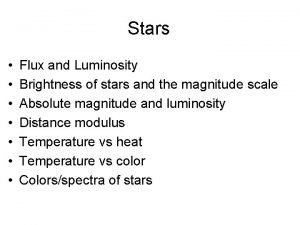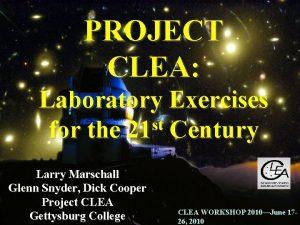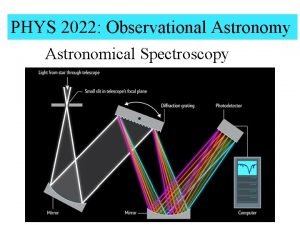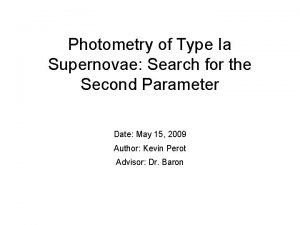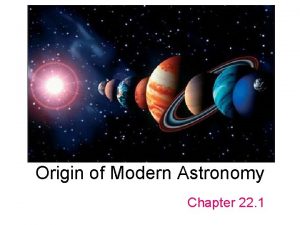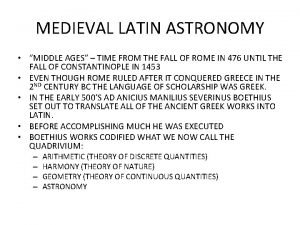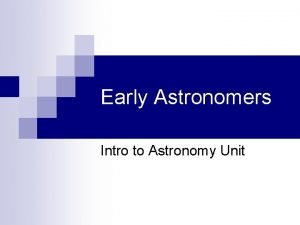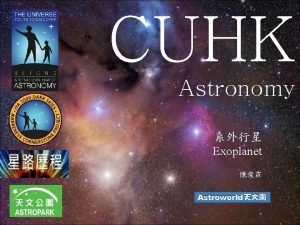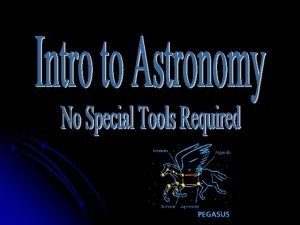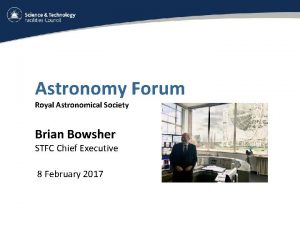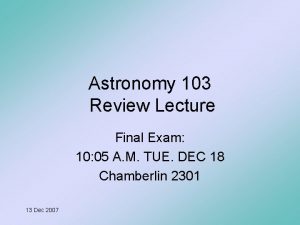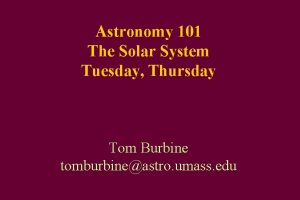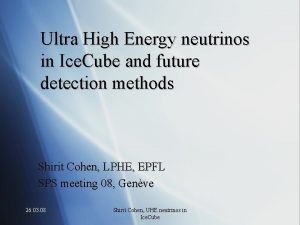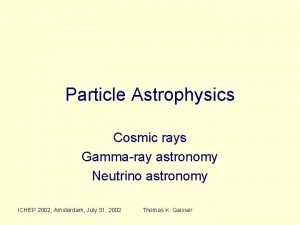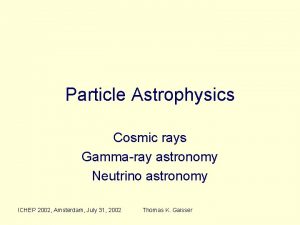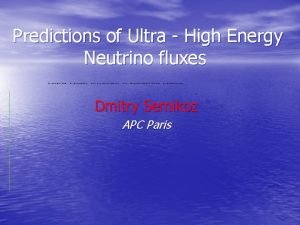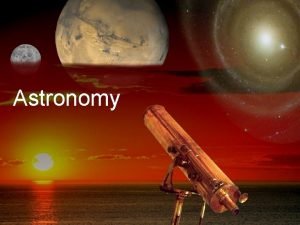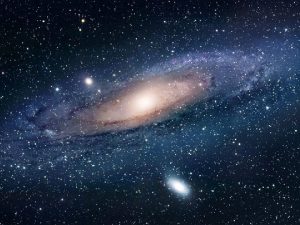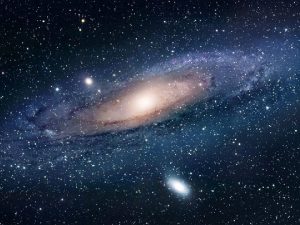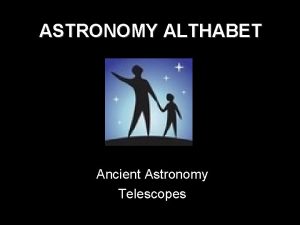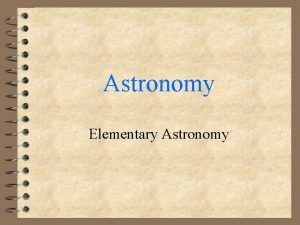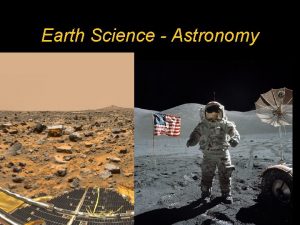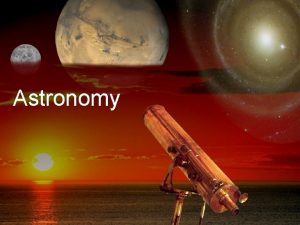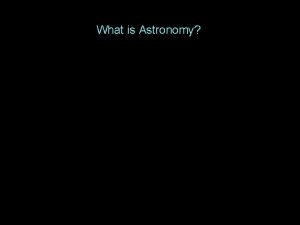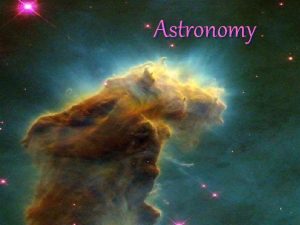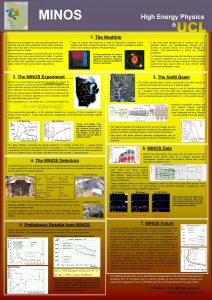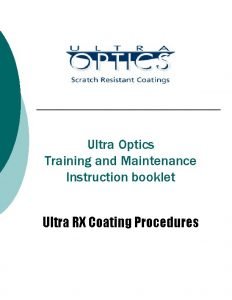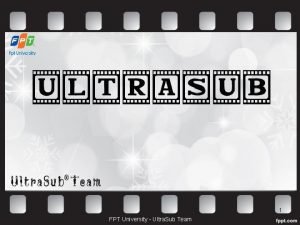Neutrino Astronomy Why Neutrinos Questions in ultra high




















































- Slides: 52

Neutrino Astronomy • Why Neutrinos • Questions in ultra high energy astrophysics – – Source of UHE cosmic rays GRBs AGN Other Physics Questions – DM, Top Down models, etc • Understanding the W-B bound – Why the kilometer scale or bigger • Overview of experimental approach – Cherenkov Detectors- Ice. Cube – Nestor, Antares, Baikal – Radio - Rice, Anita, Salsa Neutrino Astronomy

Why Neutrinos Neutrino Astronomy J. Goodman – Univ. of Maryland March 2005

Why not protons? • Protons are bent in the magnetic fields of our galaxy and local cluster • Energy of >1019 e. V needed to point back to even galactic sources • Above a few 1019 e. V GZK cutoff limits their range too Neutrino Astronomy J. Goodman – Univ. of Maryland March 2005

Effect of IR Absorption on Distant Sources IR Model of Stecker & de. Jager (1998) z= z ~Te. V g = 2 0. z= e- z = 0. 0 0. z 03 = 0. 1 3 0. e+ ~e. V g Neutrino Astronomy • No direct measurement of IR extragalactic background light exists due to zodiacal foreground. • Te. V absorption constrains IR which depends on cosmology of galaxy and star formation models. J. Goodman – Univ. of Maryland March 2005

Photon Attenuation on IR Neutrino Astronomy J. Goodman – Univ. of Maryland March 2005

Questions in ultra high energy astrophysics Source of UHE cosmic rays GRBs AGN Dark Matter Other Physics Questions Neutrino Astronomy J. Goodman – Univ. of Maryland March 2005

Origin of Cosmic Rays Atmospheric neutrinos Extragalactic flux sets scale for many acceleration models See Monday PM & Thursday AM Neutrino Astronomy J. Goodman – Univ. of Maryland March 2005

Knee Ankle New component with hard spectrum? Neutrino Astronomy J. Goodman – Univ. of Maryland March 2005

Alternative Models Bottom up Top-down – GRB fireballs – Jets in active galaxies – Accretion shocks in galaxy clusters – Galaxy mergers – Young supernova remnants – Pulsars, Magnetars – Mini-quasars – … • Observed showers either protons (or nuclei) Neutrino Astronomy – Radiation from topological defects – Decays of massive relic particles in Galactic halo – Resonant neutrino interactions on relic ’s (Z-bursts) • Mostly pions ( s, s, not protons) • Disfavored! • Highest energy cosmic rays • are not gamma rays • Overproduce Te. V-neutrinos J. Goodman – Univ. of Maryland March 2005

Neutrino Astronomy J. Goodman – Univ. of Maryland March 2005

SNRs Neutrino Astronomy J. Goodman – Univ. of Maryland March 2005

HESS: RXJ 1713 First resolved Te. V -ray image of a Shell type SNR (Resolution ~10 arcmin) Acceleration source of Cosmic Rays, but is it evidence of Protons? Neutrino Astronomy J. Goodman – Univ. of Maryland March 2005

HESS: RXJ 1713 – Molecular Clouds Neutrino Astronomy J. Goodman – Univ. of Maryland March 2005

RXJ 1713 Spectrum H. E. S. S. : full remnant CANGAROO: hotspot Index 2. 2± 0. 07± 0. 1 Index 2. 84± 0. 15± 0. 20 In favor of p 0: • no cut-off in the HE tail of HESS spectrum • signal from the direction of molecular clouds preliminary Neutrino Astronomy See HESS Talk Tuesday Afternoon J. Goodman – Univ. of Maryland March 2005

Have g-rays from p 0 decay been discovered? transparent source p 0 = p+ = p- 1< < flux predicted ~40 per km 2 per year Neutrino Astronomy 8 E N (E ) = E N (E ) accelerator beam dump (hidden source) observed -ray flux RX J 1713 -3946 (galactic center) J. Goodman – Univ. of Maryland March 2005

Milagro (Te. V) Diffuse Source See Milagro Talk Tues Afternoon Neutrino Astronomy J. Goodman – Univ. of Maryland March 2005

Active Galactic Nuclei Radiation field: Produces cosmic ray beam Neutrino Astronomy J. Goodman – Univ. of Maryland March 2005

Active Galactic Nuclei (AGN) Jets Shock fronts Fermi acceleration Black Hole Accretion Disk Neutrino Astronomy J. Goodman – Univ. of Maryland March 2005

VLA image of Cygnus A See Monday Morning AGN Session Neutrino Astronomy J. Goodman – Univ. of Maryland March 2005

GZK p + g. CMB → p + n 0. 6 x 10 -27 cm 2 + l= (ncmb s p + )-1 l= 10 Mpc Cutoff above 50 Ee. V p E = 6 x 10 19 e. V π+ + μ e n + p E ~4 x 10 19 e. V Neutrino Astronomy J. Goodman – Univ. of Maryland March 2005

GZK Cosmogenic neutrinos are guaranteed if primaries are nucleons. May be much larger fluxes, for some models, such as topological defects Neutrino Astronomy J. Goodman – Univ. of Maryland March 2005

GZK See Monday PM + Thurs AM Sess. Neutrino Astronomy J. Goodman – Univ. of Maryland March 2005

GRBs Neutrino Astronomy J. Goodman – Univ. of Maryland March 2005

GRBs Shocks: external collisions with interstellar material or internal collisions when slower material is overtaken by faster in the fireball. See Wed AM+ Thu PM GRB sessions Neutrino Astronomy J. Goodman – Univ. of Maryland March 2005

Fireball Phenomenology & The Gamma-Ray Burst (GRB) Neutrino Connection Electron --- Progenitor (Massive star) Magnetic Field ray 6 Hours 3 Days -ray ep+ Optical X-ray (2 -10 ke. V) Radio Shock variability is reflected in the complexity of the GRB time profile. E 1051 – 1054 ergs Meszaros, P R < 108 cm R 1014 cm, T 3 x 103 seconds R 1018 cm, T 3 x 1016 seconds Neutrino Astronomy J. Goodman – Univ. of Maryland March 2005

Lorentz Invariance Violation Bounds on energy dependence of the speed of light can be used to place constraints on the effective energy scale for quantum gravitational effects. E 2 = m 2 c 4 +p 2 c 2 - in the Lorentz invariant case, E 2 -c 2 p 2~E 2 x(E/EQG)a - This may be modified in some quantum gravity models. This has the important observational consequence that this will give rise to energy dependent delays between arrival times of photons. The expected time delay is : This may be measurable See Wed. from large distances. Afternoon Neutrino Astronomy Dt ~ x(E/EQG)a L/c for very high energy photons/neutrinos coming J. Goodman – Univ. of Maryland March 2005

Galactic Microquasars See Talk Monday Morning Neutrino Astronomy J. Goodman – Univ. of Maryland March 2005

What About Dark Matter? • ~85% of the matter in the Universe is Dark Matter – At most a few % of the matter is baryons – Most people believe that the lightest SUSY particle is a stable neutralino and is probably the dark matter – These are weakly interacting and heavy – Evidence of clustering See Friday Afternoon Session on Dark Matter Neutrino Astronomy J. Goodman – Univ. of Maryland March 2005

Wimp Capture c Earth m Detector Neutrino Astronomy J. Goodman – Univ. of Maryland March 2005

Wimp Detection Neutrino Astronomy J. Goodman – Univ. of Maryland March 2005

Neutrino Astronomy Explores Extra Dimensions 100 x SM GZK range See Wednesday Afternoon Session Te. V-scale gravity increases Pe. V -cross section Neutrino Astronomy J. Goodman – Univ. of Maryland March 2005

Cosmic Neutrino Factory black hole radiation enveloping black hole p + -> n + p+ ~ cosmic ray + neutrino -> p + p 0 Neutrino Astronomy ~ cosmic ray + gamma March 2005 J. Goodman – Univ. of Maryland

W-B Bound Neutrino Astronomy J. Goodman – Univ. of Maryland March 2005

Evading the Bound • “Neutrino only” sources that are optically thick to proton photo-meson interactions and from which protons cannot escape. – No observational evidence (from baryons or high energy photons) • Cores of AGNs (rather than in the jets) by photo-meson interactions or via p−p collisions in a collapsing galactic nucleus or in a cacooned black hole. – The most optimistic predictions of the AGN core model have already been ruled out by AMANDA Neutrino Astronomy J. Goodman – Univ. of Maryland March 2005

Mannheim, Protheore and Rachen Model Neutrino Astronomy J. Goodman – Univ. of Maryland March 2005

Neutrinos from Cosmic Rays ~50 events/km 2/yr Neutrino Astronomy J. Goodman – Univ. of Maryland March 2005

Size Perspective for KM 3 300 m AMANDAII 1500 m 50 m 2500 m Neutrino Astronomy J. Goodman – Univ. of Maryland March 2005

Detection Technique Cerenkov light cone muon or tau detector See Talks in this Session • The muon radiates blue light in its wake • Optical sensors capture (and map) the light J. Goodman – Univ. of Maryland Neutrino Astronomy interaction neutrino March 2005

Detection of e , , Electromagnetic and hadronic cascades O(km) long muon tracks 17 m ~5 m direction determination by cherenkov light timing Neutrino Astronomy J. Goodman – Univ. of Maryland March 2005

Muon Events Eµ= 6 Pe. V Eµ= 10 Te. V Measure energy by counting the number of fired PMT. (This is a very simple but robust method) Neutrino Astronomy J. Goodman – Univ. of Maryland March 2005

Determining Energy 10 Te. V Neutrino Astronomy 6 Pe. V J. Goodman – Univ. of Maryland 375 Te. V Cascade March 2005

Double Bang Learned, Pakvasa, 1995 t + N --> t- + X t + X (82%) Regeneration makes Earth quasi transparent for high energie ; (Halzen, Salzberg 1998, …) Also enhanced muon flux due to Secondary µ, and µ (Beacom et al. . , astro/ph 0111482) E << 1 Pe. V: Single cascade (2 cascades coincide) E ≈ 1 Pe. V: Double bang E >> 1 Pe. V: partially contained (reconstruct incoming tau track and cascade from decay) Neutrino Astronomy J. Goodman – Univ. of Maryland March 2005

Tau Cascades E << 1 Pe. V: Single cascade (2 cascades coincide) E ≈ 1 Pe. V: Double bang E >> 1 Pe. V: partially contained (reconstruct incoming tau track and cascade from decay) Neutrino Astronomy J. Goodman – Univ. of Maryland March 2005

Neutrino flavor Neutrino ID (solid) Energy and angle (shaded) Neutrino Astronomy J. Goodman – Univ. of Maryland March 2005

Tau Transparency/Regeneration • e and µ are absorbed in the Earth via charged current interactions (muons range out) • Above ~100 Te. V the Earth is opaque to e & νµ. • But, the Earth never becomes completely opaque to • Due to the short lifetime, ’s produced in charged-current interactions decay back into • Also, secondary e & νµ. fluxes are produced in the tau decays. Neutrino Astronomy J. Goodman – Univ. of Maryland March 2005

Flavor Ratios • The ratio of flavors at the source is expected to be 0: 2: 1= : : e • Since the distance to the source is >> than the oscillation length – any admixture at the source should wind up: 1: 1: 1= : : e when arriving at earth • What if that isn’t true? Neutrino Astronomy J. Goodman – Univ. of Maryland March 2005

Exotic neutrino properties if not 1: 1: 1 • Neutrino decay (Beacom, Bell, Hooper, Pakvasa& Weiler) • CPT violation (Barenboim& Quigg) • Oscillation to steriles with very tiny delta δm 2 (Crocker et al; Berezinskyet al. ) • Pseudo-Dirac mixing (Beacom, Bell, Hooper, Learned, Pakvasa& Weiler) • 3+1 or 2+2 models with sterile neutrinos (Dutta, Reno and Sarcevic) • Magnetic moment transitions (Enqvist, Keränen, Maalampi) • Varying mass neutrinos (Fardon, Nelson & Weiner; Hung & Pas) Neutrino Astronomy J. Goodman – Univ. of Maryland March 2005

Supernova Monitor B 10: 60% of Galaxy Amanda-II A-II: 95% of Galaxy Amanda-B 10 Count rates 0 5 10 sec Ice. Cube: up to LMC Neutrino Astronomy J. Goodman – Univ. of Maryland March 2005

Large Scale Neutrino Detectors ANTARES BAIKAL La-Seyne-sur-Mer, France Russia NEMO See Talks in this Session Catania, Italy NESTOR Pylos, Greece Ice. Cube, South Pole, Antarctica Neutrino Astronomy J. Goodman – Univ. of Maryland March 2005

Radio Cherenkov Detectors Rice Neutrino Astronomy Anita J. Goodman – Univ. of Maryland Salsa March 2005

Acoustic Detectors SAUND (Study of Acoustic Underwater Neutrino Detection) Neutrino Astronomy J. Goodman – Univ. of Maryland March 2005

Conclusions Neutrino Astronomy is just beginning to open a new window on the Universe! Now Soon Amanda Cherenkov arrays SK Radio Detectors Neutrino Astronomy J. Goodman – Univ. of Maryland Future ? ? ? March 2005
 Learning astronomy by doing astronomy
Learning astronomy by doing astronomy Learning astronomy by doing astronomy
Learning astronomy by doing astronomy Learning astronomy by doing astronomy
Learning astronomy by doing astronomy Neutrinos
Neutrinos Neutrinos
Neutrinos Neutrinos
Neutrinos Andreas carlsson bye bye bye
Andreas carlsson bye bye bye High point astronomy
High point astronomy Acn high speed internet
Acn high speed internet Neutrino beteckning
Neutrino beteckning Neutrino lepton number
Neutrino lepton number Emission spectrum of sodium
Emission spectrum of sodium Neutrino
Neutrino Neutrino
Neutrino Lekka cząstka elementarna mion elektron lub neutrino
Lekka cząstka elementarna mion elektron lub neutrino Who discovered neutrino
Who discovered neutrino Neutrino
Neutrino Neutrino
Neutrino Gabriela barenboim
Gabriela barenboim Neutrino
Neutrino Paris traceroute
Paris traceroute Neutrino
Neutrino Neutrino symbol
Neutrino symbol Neutrino
Neutrino Neutrino
Neutrino Cerenkov
Cerenkov Neutrino
Neutrino Solar neutrino
Solar neutrino Solar neutrino
Solar neutrino Neutrino mass
Neutrino mass Neutrino
Neutrino Neutrino interaction with matter
Neutrino interaction with matter Neutrino mass
Neutrino mass Astronomy questions and answers multiple choice
Astronomy questions and answers multiple choice Don't ask why why why
Don't ask why why why Branches of astronomy
Branches of astronomy Claudius ptolemy astronomy contributions
Claudius ptolemy astronomy contributions Aristotle astronomy
Aristotle astronomy Swinburne astronomy online
Swinburne astronomy online Mizar luminosity
Mizar luminosity Absolute magnitude to luminosity
Absolute magnitude to luminosity Clea astronomy
Clea astronomy Phys2022
Phys2022 Distance ladder astronomy
Distance ladder astronomy Origin of modern astronomy chapter 22
Origin of modern astronomy chapter 22 Astronomy in the middle ages
Astronomy in the middle ages Astronomy definition earth science
Astronomy definition earth science Claudius ptolemy astronomy contributions
Claudius ptolemy astronomy contributions Cuhk astronomy
Cuhk astronomy Astronomy vs astrology definition
Astronomy vs astrology definition Astronomy forum uk
Astronomy forum uk Astronomy 103 final exam
Astronomy 103 final exam Astronomy 101 formulas
Astronomy 101 formulas



